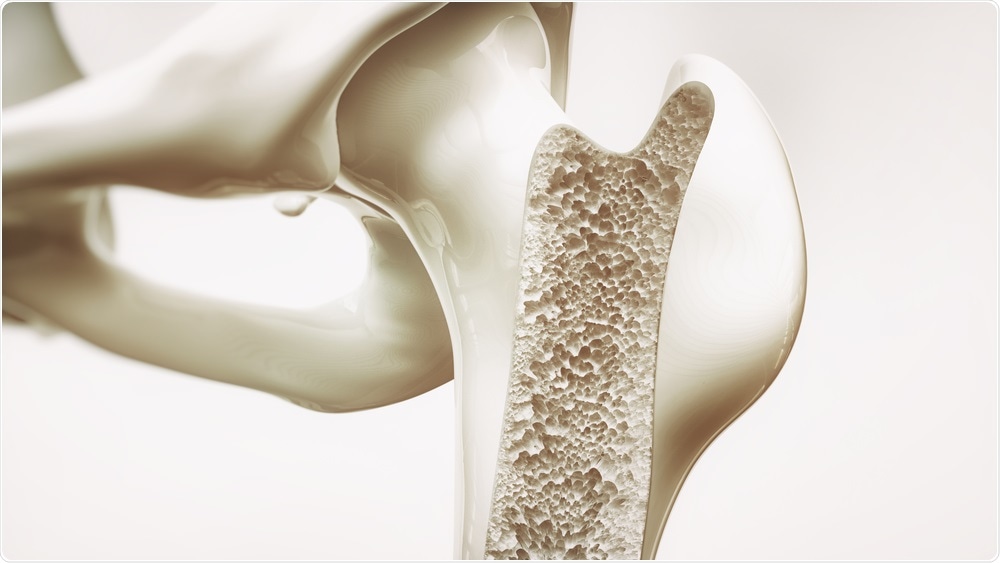A study by researchers at Columbia University suggests that the main coordinator of the body’s fight-or-flight response is not adrenalin, but another hormone called osteocalcin, which is secreted by bone.
“The findings suggest osteocalcin—not adrenaline—is the gatekeeper that determines when bodies shift into fight-or-flight mode,” says study leader Gérard Karsenty.
 Crevis | Shutterstock
Crevis | Shutterstock
When suddenly faced with a perceived threat, our heart and breathing rates increase, blood sugar spikes, breathing deepens and body temperature rises – all of which provides us with the extra energy needed to fight or run away. This fight-or-flight response is controlled by nerve pathways from the brain and hormones produced by the adrenal glands.
Now, Karsenty and colleagues have discovered that the osteocalcin protein, which is released by bone cells called osteoblasts, also serves to coordinate this response.
Skeleton much more than an “assembly of calcified tubes”
"The view of bones as merely an assembly of calcified tubes is deeply entrenched in our biomedical culture,” says Karsenty, but the skeleton is much more than a scaffold that supports the body, he adds.
About a decade ago, Karsenty’s lab demonstrated that the skeleton has major influences on other organs including the brain and muscles.
A study they conducted in 2007 showed that osteocalcin regulates blood sugar levels and burns fat. Later work showed that the hormone also maintained brain function and fitness levels in aged mice, restoring the animals’ memories and boosting their performance during exercise.
The findings prompted Karsenty to question whether part of the reason animals have evolved bony skeletons is to escape danger.
Since the studies Karsenty and team conducted, many others have shown that osteocalcin helps regulate metabolism, improves memory and increases animals’ running speed and endurance levels.
Bones may play a role in protecting against danger
If the skeleton has evolved to play a part in escaping danger, then it should also be involved in the fight-or-flight response that is triggered by danger, hypothesized Karsenty. The current study, recently published in the journal Cell Metabolism, supports this theory.
When the researchers exposed mice to several stressors, including fox urine scent and an electric shock to the foot, the animals’ blood osteocalcin level quadrupled within 2 to 3 minutes.
A classic stressor in people – public speaking – had a similar effect. When participants were asked to speak in front of an audience, their blood osteocalcin level spiked.
If you think of bone as something that evolved to protect the organism from danger—the skull protects the brain from trauma, the skeleton allows vertebrates to escape predators, and even the bones in the ear alert us to approaching danger—the hormonal functions of osteocalcin begin to make sense."
Gérard Karsenty, Lead Author
Osteocalcin is needed to trigger the fight-or-flight
Next, the researchers set out to determine whether osteocalcin is required to induce the fight-or-flight mode.
When the team exposed mice that had their osteocalcin gene knocked out to the same stressors as the normal mice, the animals barely reacted.
"In bony vertebrates, the acute stress response is not possible without osteocalcin," says Karsenty. “It completely changes how we think about how acute stress responses occur."
By contrast, normal mice that were given just one injection of osteocalcin demonstrated a full fight-or-flight response, even in the absence of a trigger.
"This shows us that circulating levels of osteocalcin are enough to drive the acute stress response," says Karsenty.
How does osteocalcin trigger the response?
After probing the neural connections between the animals’ brains and bones, Karsenty and team discovered how osteocalcin triggers the shift to fight-or-flight mode.
They found that when the amygdala in the animals’ brains sensed danger, it prompted bone cells called osteoblasts to release osteocalcin and flood the bloodstream with the hormone.
The hormone then reduced activity in the parasympathetic nervous system, which usually slows the heart rate and breathing. With the brakes taken off this system, the body’s stress response, including the release of adrenalin, was unleashed.
Karsenty says the findings help to explain why rodents without adrenal glands and adrenalin-deficient patients can still have strong physical responses to danger.
What do other experts think?
Bone physiologist at Rutgers University in New Brunswick, Patricia Buckendahl, has referred to the study as “definitely newsworthy” and said it does support the hypothesis that bones evolved to help animals escape predators and other threats.
Buckendahl, who was not involved in the current study, presented the first evidence 20 years ago that osteocalcin serves as a stress hormone in rats, but the idea was not taken seriously at the time, she says: “I’ve always said bones are a heck of a lot more than a place to store calcium.”
Karsenty thinks the findings suggest a radical re-think is needed over the role of bones, which have previously been largely regarded as inert structures.
They may have evolved to protect us from acute danger by activating the flight-or-fight response, optimizing muscle function, providing the structural framework needed for our bodies to move and escape, and forming a protective cage around our organs, he suggests.
Neuroscientist Robin McAllen from the University of Melbourne says at this stage it is unclear why the body has different ways of mounting the flight-or-fight response – through bone, direct nerve pathways, and the adrenal glands – but it may be so that we have back-ups in place if one system fails.
Journal reference:
Berger, J. M., et al. (2019). Mediation of the Acute Stress Response by the Skeleton. Cell Metabolism. https://doi.org/10.1016/j.cmet.2019.08.012